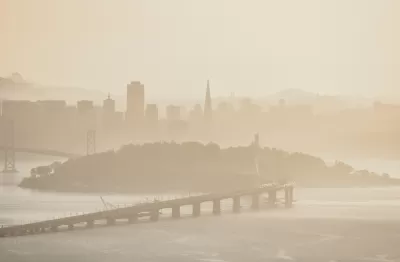No cause has yet been attributed to California's deadliest wildfires, but the connections to fallen power lines and exploding transformers, maintained by PG&E, have been exposed in a series of reports by the Bay Area News Group.

On Oct. 11, the California Department of Forestry and Fire Protection (CAL FIRE) "said that investigators have started looking into whether toppled power wires and exploding transformers Sunday night [Oct. 8] may have ignited the simultaneous string of blazes," report Matthias Gafni and Emily DeRuy in The Mercury News.
The acknowledgment followed publication of a review by the Bay Area News Group of Sonoma County firefighters’ radio transmissions in the fires’ infancy that found that there were numerous downed and arcing wires. In the first 90 minutes Sunday night, firefighters were sent to 10 different spots where problems had been reported with the area’s electrical infrastructure. The crews reported seeing sparking lines and transformers.
PG&E acknowledges there were troubles with its equipment Sunday night, but says blaming the utility’s electrical system for the fires at this point would be “highly speculative.” It has labeled the conditions in the first hours of the fires a “historic wind event.”
Mapping and regulations
Gafni and DeRuy report that a bill approved last year, SB 1463: Electrical lines: mitigation of wildfire risks, by Sen. John Moorlach, R-Costa Mesa, "would have required the state to identify the places most at risk for wildfires and would have required the [California Public Utilities Commission] CPUC to beef up plans to prevent fires sparked by power lines — including moving lines underground if necessary."
Gov. Jerry Brown (D) vetoed the bill, claiming it was "unnecessary" because "the Commission and CalFire have been doing just that through the existing proceeding on fire-threat maps and fire-safety regulations."
Fire hazard mapping, it turns out, is key to determining which transmission wires are most at risk. Gafni reports on Oct. 22 that the CPUC has been working to update the fire maps for 10 years. Worse yet, the state's electric utilities have "helped stall the effort."
A review of the mapping project by the Bay Area News Group shows that utilities have repeatedly asked to slow down the effort and argued as recently as July that, as PG&E put it, certain proposed regulations would “add unnecessary costs to construction and maintenance projects in rural areas.”
Gafni also reports that the Northern California wildfires have "killed at least 42 people and destroyed more than 5,000 homes and businesses."
Litigation
DeRuy reports on Oct. 18 that a Santa Rosa couple, Wayne and Jennifer Harvell, who lived in the devastated Coffey Park neighborhood, is the first to sue PG&E over their role in the fires.
The Harvells allege that the utility company failed to adequately maintain power lines, leading to the destruction of their Coffey Park house and at least 1,000 others in the neighborhood as the Tubbs fire consumed the region.
A table [jpg] showing notable wildfires caused by power lines since 1923, including acres burned and structures destroyed, was provided by state Sen. Jerry Hill (D-San Mateo), who has been both a CPUC and PG&E watchdog since a PG&E natural gas main exploded in San Bruno, killing eight people.
Hat tip to David McCoard.
FULL STORY: Wine Country fires: Gov. Brown vetoed 2016 bill aimed at power line, wildfire safety

Maui's Vacation Rental Debate Turns Ugly
Verbal attacks, misinformation campaigns and fistfights plague a high-stakes debate to convert thousands of vacation rentals into long-term housing.

Planetizen Federal Action Tracker
A weekly monitor of how Trump’s orders and actions are impacting planners and planning in America.

San Francisco Suspends Traffic Calming Amidst Record Deaths
Citing “a challenging fiscal landscape,” the city will cease the program on the heels of 42 traffic deaths, including 24 pedestrians.

Defunct Pittsburgh Power Plant to Become Residential Tower
A decommissioned steam heat plant will be redeveloped into almost 100 affordable housing units.

Trump Prompts Restructuring of Transportation Research Board in “Unprecedented Overreach”
The TRB has eliminated more than half of its committees including those focused on climate, equity, and cities.

Amtrak Rolls Out New Orleans to Alabama “Mardi Gras” Train
The new service will operate morning and evening departures between Mobile and New Orleans.
Urban Design for Planners 1: Software Tools
This six-course series explores essential urban design concepts using open source software and equips planners with the tools they need to participate fully in the urban design process.
Planning for Universal Design
Learn the tools for implementing Universal Design in planning regulations.
Heyer Gruel & Associates PA
JM Goldson LLC
Custer County Colorado
City of Camden Redevelopment Agency
City of Astoria
Transportation Research & Education Center (TREC) at Portland State University
Jefferson Parish Government
Camden Redevelopment Agency
City of Claremont




























